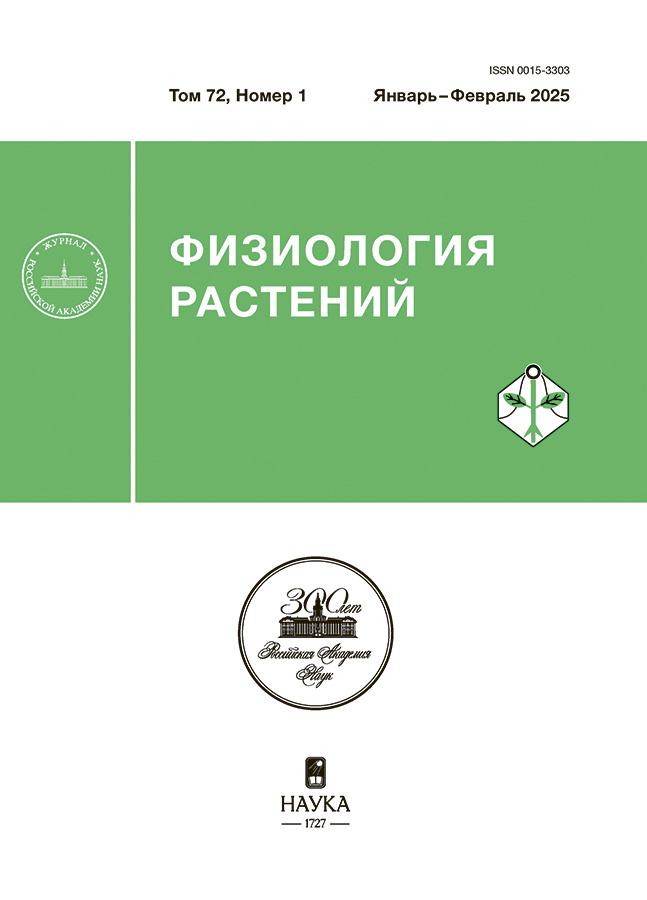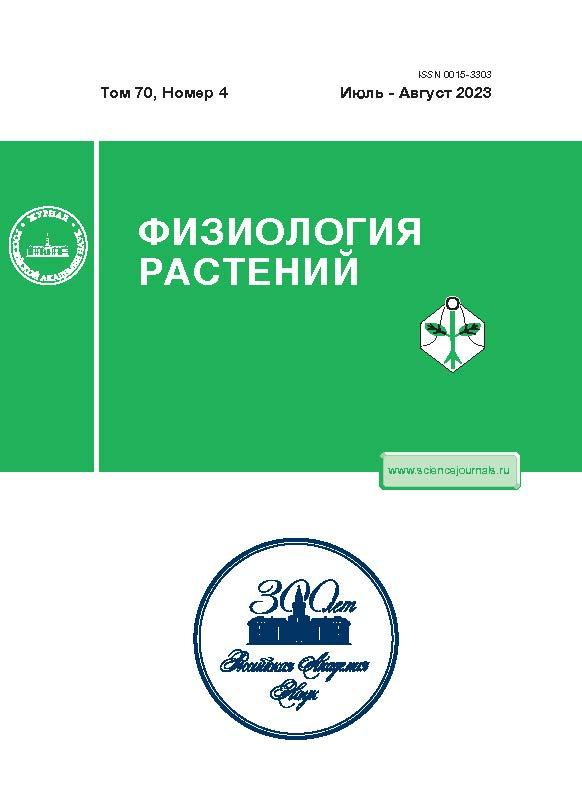Daily Short-Term Temperature Drops Can Alleviate the Negative Effect of Continuous Lighting on the Photosynthetic Apparatus in Plants
- Authors: Ikkonen E.N.1, Shibaeva T.G.1, Sherudilo E.G.1, Titov A.F.1
-
Affiliations:
- Institute of Biology, Karelian Research Center, Russian Academy of Sciences
- Issue: Vol 70, No 4 (2023)
- Pages: 402-409
- Section: ЭКСПЕРИМЕНТАЛЬНЫЕ СТАТЬИ
- URL: https://cardiosomatics.ru/0015-3303/article/view/648158
- DOI: https://doi.org/10.31857/S0015330323600092
- EDN: https://elibrary.ru/QAVQOK
- ID: 648158
Cite item
Abstract
Several crops (tomato, eggplant, sweet pepper, and cucumber) were used to examine the impact of continuous (24 h a day) lighting on photosynthetic characteristics of plants grown permanently at 26°C and those exposed daily to short-term (2 h) cooling at 10°C (temperature-drop treatments). The plant response was assessed by indices characterizing the pigment complex and the photosynthetic activity of leaves. Growing plans under continuous light at a constant temperature resulted in leaf photodamage and photoinhibition in all four species, although to varying degrees. The temperature-drop treatments prevented the photodamage of leaves under continuous light in all species and enabled high sustainable levels of photosynthetic activity in tomato, pepper, and cucumber. The results suggest that temperature-drop treatments can be regarded as an agricultural technique that exploits the benefits of continuous lighting while mitigating the negative effects of constant light. However, the effectiveness of this technique would depend on the choice of optimal intensities and durations of the drop treatment since these parameters may vary depending on plant species.
About the authors
E. N. Ikkonen
Institute of Biology, Karelian Research Center, Russian Academy of Sciences
Email: likkonen@gmail.com
Russian Federation, Petrozavodsk
T. G. Shibaeva
Institute of Biology, Karelian Research Center, Russian Academy of Sciences
Email: likkonen@gmail.com
Russian Federation, Petrozavodsk
E. G. Sherudilo
Institute of Biology, Karelian Research Center, Russian Academy of Sciences
Email: likkonen@gmail.com
Russian Federation, Petrozavodsk
A. F. Titov
Institute of Biology, Karelian Research Center, Russian Academy of Sciences
Author for correspondence.
Email: likkonen@gmail.com
Russian Federation, Petrozavodsk
References
- Sysoeva M.I., Markovskaya E.F., Shibaeva T.G. Plants under continuous light: A review // Plant Stress. 2010. V. 4. P. 5.
- Velez-Ramirez A.I., van Ieperen W., Vreugdenhil D., Millenaar F.F. Plants under continuous light // Trends Plant Sci. 2011. V. 16. P. 310. 10.1016/j.tplants.2011.02.003' target='_blank'>http://dx.doi.org/doi: 10.1016/j.tplants.2011.02.003
- Hague M.S., Kjaer K.H., Roserqvist E., Ottosen C.O. Continuous light increases growth, daily carbon gain, antioxidants, and alters carbohydrate metabolism in a cultivated and a wild tomato species // Front. Plant Sci. 2015. V. 6. P. 522. https://doi.org/10.3389/fpls.2015.00522
- Ohtake N., Ishikura M., Suzuki H. Continuous irradiation with alternating red and blue light enhances plant growth while keeping nutritional quality in lettuce // Hort. Sci. 2018. V. 53. P. 1804. https://doi.org/10.21273/HORTSCI13469-18
- Lanoue J., Zheng J., Little C., Thibodeau A., Grodzinski B., Hao X. Alternating red and blue light-emitting diodes allows for injury-free tomato production with continuous lighting // Front. Plant Sci. 2019. V. 10. P. 1114. https://doi.org/10.3389/fpls.2019.01114
- Shibaeva T.G., Mamaev A.V., Sherudilo E.G., Titov A.F. The role of the photosynthetic daily light integral in plant response to extended photoperiods // Russ. J. Plant Physiol. 2022. V. 69. P. 7. https://doi.org/10.1134/S1021443722010216
- Shibaeva T.G., Sherudilo E.G., Rubaeva A.A., Titov A.F. Continuous lighting enhances yield and nutritional value of four genotypes of Brassicaceae microgreens // Plants. 2022. V. 11. P. 176. https://doi.org/10.3390/plants11020176
- Shibaeva T.G., Mamaev A.V., Titov A.F. Possible physiological mechanisms of leaf photodamage in plants grown under continuous lighting // Russ. J. Plant Physiol. 2023. V. 70. P. https://doi.org/10.31857/S0015330322600541
- Kitaya Y., Niu G., Kozai T., Ohashi M. Photosynthetic photon flux, photoperiod, and CO2 concentration affect growth and morphology of lettuce plug transplants // Hort. Sci. 1998. V. 33. P. 988. https://doi.org/10.21273/HORTSCI.33.6.988
- Ohyama K., Kozai T. Estimating electric energy consumption and its cost in a transplant production factory with artificial lighting: a case study // J. Soc. High Technol. Agr. 1998. V. 10. P. 96.
- Ohyama K., Manabe K., Omura Y., Kubota C., Kozai T. A comparison between closed-type and open-type transplant production systems with respect to quality of tomato plug transplants and resource consumption during summer // Environ. Control Biol. 2003. V. 41. P. 57. https://doi.org/10.2525/ecb1963.41.57
- Ohyama K., Manabe K., Omura Y., Kozai T. Potential use of a 24-hour photoperiod (continuous light) with alternating air temperature for production of tomato plug transplants in a closed system // Hort. Sci. 2005. V. 40. P. 374. https://doi.org/10.21273/HORTSCI.40.2.374
- Hillman W.S. Injury of tomato plants by continuous light and unfavorable photoperiodic cycles // Amer. J. Bot. 1956. V. 43. P. 89. https://doi.org/10.2307/2438816
- Bradley F.M., Janes H.W. Carbon partitioning in tomato leaves exposed to continuous light // Acta Hort. 1985. V. 174. P. 293. https://doi.org/10.17660/ActaHortic.1985.174.37
- Vézina F., Trudel M.J., Gosselin A. Influence du mode d’utilisation de l’éclairage d’appoint sur la productivité et la physiologie de la tomate de serre // Can. J. Plant Sci. 1991. V. 71. P. 923. https://doi.org/10.4141/cjps91-132
- Murage E.N., Sato Y., Masuda M. Influence of light quality, PPFD, and temperature on leaf chlorosis of eggplants grown under continuous illuminations // Sci. Hort. 1997. V. 68. P. 73. https://doi.org/10.1016/S0304-4238(96)00953-3
- Demers D.A., Gosselin A. Growing greenhouse tomato and sweet pepper under supplemental lighting: optimal photoperiod, negative effects of long photoperiod and their causes // Acta Hort. 2002. V. 580. P. 83. https://doi.org/10.17660/ActaHortic.2002.580.9
- Ohyama K., Omura Y., Kozai T. Effects of air temperature regimes on physiological disorders and floral development of tomato seedlings grown under continuous light // Hort. Sci. 2005. V. 40. P. 1304. https://doi.org/10.21273/HORTSCI.40.5.1304
- Matsuda R., Ozawa N., Fujiwara K. Leaf photosynthesis, plant growth, and carbohydrate accumulation of tomato under different photoperiods and diurnal temperature differences // Sci. Hort. 2014. V. 170. P. 150. https://doi.org/10.1016/j.scienta.2014.03.014
- Hague M., de Sousa A., Soares C., Kjaer K.H., Fidalgo F., Rosenqvist E., Ottosen C.-O. Temperature variation under continuous light restores tomato leaf photosynthesis and maintains the diurnal pattern in stomatal conductance // Front. Plant Sci. 2017. V. 8. P. 1602. https://doi.org/10.3389/fpls.2017.01602
- Shibaeva T.G., Mamaev A.V., Sherudilo E.G., Ikkonen E.N., Titov A.F. Age-related changes in sensitivity of tomato (Solanum lycopersicum L.) leaves to continuous light // Russ. J. Plant Physiol. 2021. V. 68. P. 948. https://doi.org/10.1134/S1021443721040154
- Tibbitts T.W., Bennett S.M., Cao W. Control of continuous irradiation injury on potato with daily temperature cycling // Plant Physiol. 1990. V. 93. P. 409. https://doi.org/10.1104/pp.93.2.409
- Kristoffersen T. Interactions of photoperiod and temperature in growth and development of young tomato plants (Lycopersicon esculentum Mill.) // Physiol. Plant. 1963. V. 16. P. 1.
- Nilwik H.J.M. Growth analysis of sweet pepper (Capsicum annuum L.) 2. Interacting effects of irradiance, temperature and plant age in controlled conditions // Ann. Bot. 1981. V. 48. P. 136. https://doi.org/10.1093/oxfordjournals.aob.a086107
- Bünning E. Untersuchungen uber die autonomen tagesperiodischen Bewegungen der Primarblatten von Phaseolus multiflorus // Jahrbücher für wissenchaftiche Botanik. 1931. V. 75. P. 439.
- Ikkonen E.N., Shibaeva T.G., Rosenqwist E., Ottosen C.-O. Daily temperature drop prevents inhibition of photosynthesis in tomato plants under continuous light // Photosynthetica. 2015. V. 53. P. 389. https://doi.org/10.1007/s11099-015-0115-4
- Sysoeva M.I., Shibaeva T.G., Sherudilo E.G., Ikkonen E.N. Control of continuous irradiation injury on tomato plants with a temperature drop // Acta Hort. 2012. V. 956. P. 283. https://doi.org/10.17660/ActaHortic.2012.956.32
- Shibaeva T.G., Sherudilo E.G. Immediate and delayed effects of diurnal temperature drops on growth and reproductive development of tomato plants grown under continuous lighting // Russ. J. Plant Physiol. 2015. V. 62. P. 328. https://doi.org/10.1134/S1021443715030176
- Lichtenthaler H.K., Wellburn A.R. Determinations of total carotenoids and chlorophylls a and b of leaf extracts in different solvents // Biochem. Soc. 1983. V. 603. P. 591. https://doi.org/10.1042/bst0110591
- Lichtenthaler H.K. Chlorophylls and carotenoids: pigments of photosynthetic biomembranes // Methods Enzymol. 1987. V. 148. P. 350. https://doi.org/10.1016/0076-6879(87)48036-1
- Shibaeva T.G., Markovskaya E.F., Ikkonen E.N., Sherudilo E.G. Control of continuous irradiation injury on tomato plants with a temperature drop: effectiveness evaluation // Russ. Agric. Sci. 2015. V. 41. P. 419. https://doi.org/10.3103/S1068367415060221
- Omura Y., Oshima Y., Kubota C., Kozai T. Treatments of fluctuating temperature under continuous light enabled the production of quality transplants of tomato, eggplant and sweet pepper // Hort. Sci. 2001. V. 36. № 3. P. 586.
- Сысоева М.И., Шибаева Т.Г., Шерудило Е.Г. Способ выращивания рассады томата в защищенном грунте // Бюллетень Федеральной службы по интеллектуальной собственности, патентам и товарным знакам. 2013. № 28. 6 с.
- Шибаева Т.Г., Шерудило Е.Г., Икконен Е.Н., Титов А.Ф. Влияние кратковременных ежесуточных понижений температуры на активность антиоксидантных ферментов // Труды КарНЦ РАН. Сер. Экспериментальная биология. 2015. № 12. С. 107. https://doi.org/10.17076/eb241
- Ikkonen E.N., Sherudilo E.G., Shibaeva T.G., Grabelnykh O.I. Salicylhydroxamic acid-resistant and sensitive components of respiration in chilling-sensitive plants subjected to a daily short-term temperature drop // Russ. J. Plant Physiol. 2020. V. 67. P. 60. https://doi.org/10.1134/S1021443719050066
- Garmash E.V. Mitochondrial respiration of the photosynthesizing cell // Russ. J. Plant Physiol. 2016. V. 63. P. 13. https://doi.org/10.1134/S1021443715060072
- Икконен Е.Н., Шибаева Т.Г., Шерудило Е.Г., Титов А.Ф. Влияние ДРОП-воздействий на эффективность использования световой энергии в процессе фотосинтеза у растений огурца // Труды КарНЦ РАН. Серия “Экспериментальная биология”. 2016. № 6. С. 49. https://doi.org/10.17076/eb319
- Klimov S.V., Astakhova N.V., Trunova T.I. Relationship between plant cold tolerance, photosynthesis and ultrastructural modifications of cells and chloroplasts // Russ. J. Plant Physiol. 1997. V. 44. P. 759.
- Марковская Е.Ф., Шерудило Е.Г., Рипатти П.О., Сысоева М.И. Роль липидов в устойчивости семядольных листьев огурца к постоянному и кратковременному периодическому действию низкой закаливающей температуры // Труды Кар НЦ РАН. Серия биологическая. 2009. № 3. С. 67.
- Климов С.В., Трунова Т.И., Мокроносов А.Т. Механизм адаптации растений к неблагоприятным условиям окружающей среды через изменение донорно-акцепторных отношений // Физиология растений. 1990. Т. 37. С. 1024.
Supplementary files














